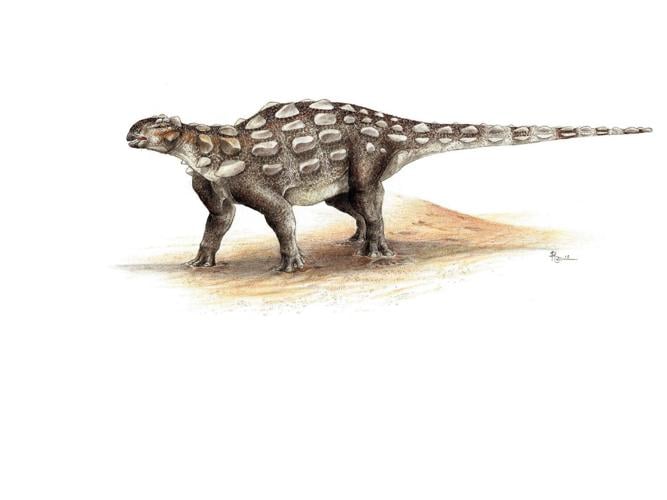
Artist's impression of an ankylosaur. (Sydney Mohr via SWNS)
By Stephen Beech
Footprints of armored dinosaurs with tail clubs have been identified for the first time.
The 100-million-year-old fossilized prints were found at two different locations in the Canadian Rockies.
Researchers explained that there are two main groups of ankylosaurs. Nodosaurid ankylosaurs have a flexible tail and four toes, while ankylosaurid ankylosaurs have a sledgehammer-like tail club, and only three toes on their feet.
Unlike the well-known ankylosaur footprints called Tetrapodosaurus borealis found across North America, which have four toes, the new tracks have only three - making them the first known examples of ankylosaurid ankylosaur footprints anywhere in the world.

Dr. Victoria Arbour (Royal BC Museum) with the type specimen of Ruopodosaurus still in the field at Wolverine River in August 2023. (Royal BC Museum via SWNS)
The research team named the new species Ruopodosaurus clava, meaning "the tumbled-down lizard with a club/mace" - referencing both the mountainous location in which the tracks were found and the distinctive tail clubs of these dinosaurs.
The research team reported their findings in the Journal of Vertebrate Palaeontology.
Dr. Victoria Arbour, the curator of paleontology at the Royal BC Museum, said: “While we don’t know exactly what the dinosaur that made Ruopodosaurus footprints looked like, we know that it would have been about 5-6 meters long, spiky and armored, and with a stiff tail or a full tail club.
“Ankylosaurs are my favorite group of dinosaurs to work on, so being able to identify new examples of these dinosaurs in British Columbia is really exciting for me.”

Palaeontologists from the Tumbler Ridge Museum and Royal BC Museum created a silicone mould of the type specimen of Ruopodosaurus in August 2024. (Royal BC Museum via SWNS)
Dr. Charles Helm, scientific advisor at the Tumbler Ridge Museum, had noted the presence of several of the three-toed ankylosaur trackways around Tumbler Ridge for several years and invited Dr Arbour to work together to identify and interpret them during a visit in 2023.
The tracks date back to the middle of the Cretaceous period, about 100 to 94 million years ago, according to the researchers.
No bones from ankylosaurids have been found in North America from about 100 to 84 million years ago, leading to some speculation that ankylosaurids had disappeared from North America during that period.

Ruopodosaurus hand and footprints from Tumbler Ridge: Ruopodosaurus footprints from Tumbler Ridge. (V. Arbour/C. Helm. via SWNS)
But the footprints show that tail-clubbed ankylosaurs were alive and well in North America during the gap in the skeletal fossil record.
The discovery also shows that the two main types of ankylosaurs - nodosaurids and ankylosaurids, including this new three-toed species - co-existed in the same region during that time.
Dr. Helm said: “Ever since two young boys discovered an ankylosaur trackway close to Tumbler Ridge in the year 2000, ankylosaurs and Tumbler Ridge have been synonymous.

Calla Scott and Teague Dickson consolidating the Ruopodosaurus holotype before moulding in August 2024. (Royal BC Museum via SWNS)
"It is really exciting to now know through this research that there are two types of ankylosaurs that called this region home and that Ruopodosaurus has only been identified in this part of Canada."
Dr. Arbour added: “This study also highlights how important the Peace Region of north-eastern BC is for understanding the evolution of dinosaurs in North America – there’s still lots more to be discovered."






















